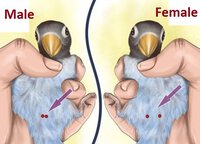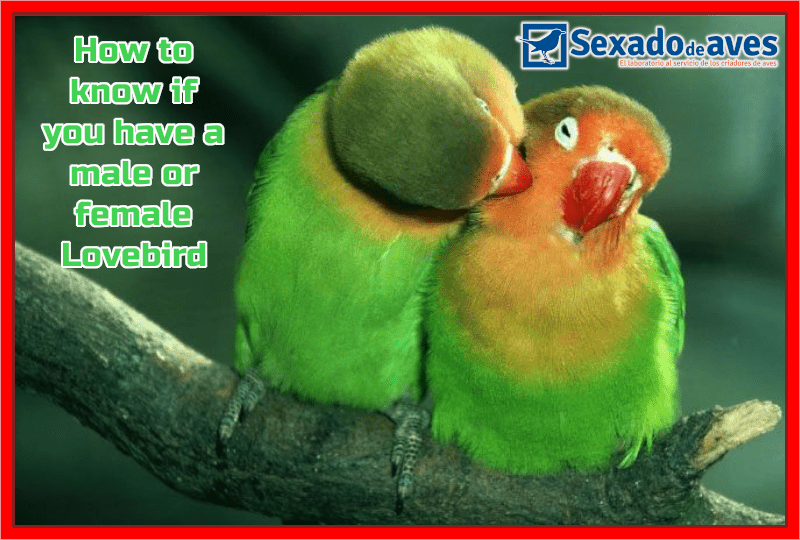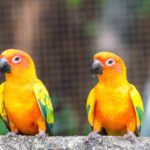Determining the gender of lovebirds is often difficult, as they are monomorphic species. Generally, DNA or surgical sexing by a vet is required for accuracy.
Lovebirds captivate bird enthusiasts with their vibrant hues and affectionate nature. Known for forming strong pair bonds, these small parrots are popular pets that exhibit similar plumage irrespective of gender, challenging owners to discern their sex. In aviculture, understanding the sex of your lovebirds is vital for breeding purposes and for providing appropriate care.
While subtle behavioral and physical differences can sometimes offer clues, most experts agree that conclusive gender identification typically involves scientific methods. It’s essential for lovebird caretakers to approach gender determination with patience and consider professional assistance to ensure certainty.

Credit: m.youtube.com
Sexing Lovebirds: Can You Tell The Difference?
Discerning the gender of lovebirds often feels like solving a nature’s puzzle. Lovebirds are known for their vivid colors and affectionate nature. But, unlike some other birds, they don’t exhibit strong sexual dimorphism. This means males and females look very much alike. So how can you tell them apart? Let’s dive into the subtle signs that might help you determine the gender of your feathery friends.
Visual Clues And Common Misconceptions
It’s commonly thought that you can guess a lovebird’s gender by its color or markings. In truth, these visual cues rarely provide accurate hints. Both males and females can flaunt a rainbow of colors. There are, however, subtle differences to look for:
- Pelvic bones: Gently feel the pelvic bones near the bird’s vent. A female’s bones may feel wider apart.
- Head and beak shape: Males may have a slightly rounder head and a more prominent beak.
These signs are not foolproof and can lead to common misconceptions. Considering a DNA test or a vet visit might offer more definitive answers.
Behavioral Indicators Of Gender
Behavior can be telling. While both genders sing and chatter, males often show-off with more noise. Another behavior to note is how they interact with toys or mirrors:
- Aggressiveness towards toys: Males might exhibit more aggression.
- Nesting behavior: A female may shred paper or exhibit nesting behavior even without a nest.
Observing social interactions helps too. Females may show dominance over the food dish or be more territorial. These behaviors emerge as lovebirds reach maturity, making it easier to deduce their gender.
Watch your lovebirds over a period of time. Note their interactions and behaviors. With patience and careful observation, you may just determine the gender of these delightful avian companions.
Anatomy Of Lovebirds: Male Vs Female
Telling a lovebird’s gender can be a real mystery because males and females look almost identical. Understanding their anatomy helps reveal subtle differences. Biological and physical cues provide insights. Let’s examine these unique features.
Physical Differences Examined Closer
Determining whether your lovebird is male or female could be done through close observation of physical characteristics. Despite their similarities, seasoned bird enthusiasts note several ways to tell them apart.
- Males often have a broader head and more square shape.
- Females could exhibit a more rounded head and fuller figure.
- Feather color intensity could differ, with males sometimes sporting slightly more vibrant plumage.
The Pelvic Bone Test: Myths And Facts
The pelvic bone test is a traditional method used to distinguish genders. The theory goes: females have wider pelvic bones for egg-laying. Carefully feeling the bones above the bird’s vent could provide a clue.
| Aspect | Myth | Fact |
|---|---|---|
| Pelvic Bone Width | Only reliable in mature females | Can be unreliable due to bird’s condition or breed |
| Method | Simple to perform | Requires expertise to avoid harm |
Experts warn that incorrect handling can injure your lovebird. It’s advised to seek professional help for this test.
Genetic Testing For Lovebirds
Discovering whether your lovebird is a male or female can be quite a task. Traditional methods often lead to confusion and inaccuracies. This is where genetic testing for lovebirds comes as a savior. By examining your bird’s DNA, you can determine its gender with the highest certainty. Let’s explore DNA sampling, a trusted technique, and how to interpret the results you receive.
Dna Sampling: A Reliable Method
Genetic testing starts with DNA sampling. This process involves collecting a sample of your lovebird’s cells. Vets usually use a blood sample or a feather for this. These samples contain the bird’s genetic material necessary for testing. The process is quick, and it is safe for your lovebird.
- Blood sample: A vet draws a small amount of blood.
- Feather: Vets often pluck a couple of chest feathers.
After collection, the sample goes to a lab. Here, experts analyze it to determine the gender.
Interpreting Genetic Test Results
Once the lab completes the test, you will receive a report. This report tells you whether your lovebird is male or female. It provides a clear-cut answer, unlike physical or behavioral observations that can mislead. The results come in simple terms:
| Z chromosome | W chromosome | Gender |
|---|---|---|
| ZZ | 0 | Male |
| Z | W | Female |
The presence of two Z chromosomes indicates a male bird. One Z and one W chromosome mean a female. This data ensures you care for your lovebird correctly.
Monomorphic Traits In Lovebirds
Lovebirds boast charming colors and sociable personalities, captivating bird enthusiasts worldwide. Their monomorphic traits make them truly unique within the avian community. This means both male and female lovebirds appear remarkably similar to human observers. Deciphering their genders can be a subtle art, often stumping even the most experienced bird lovers.
Challenges In Distinguishing Genders Visually
Eyes alone may not reveal the secrets of a lovebird’s gender. Their identical feathers, sizes, and colors intertwine, creating a puzzle. Each bird carries the same visual markers, turning gender identification into a guessing game. The lack of distinct sexual dimorphism is their nature’s riddle.
Species Variations And Their Impact On Gender Identification
- Agapornis Roseicollis – Both sexes mirror each other with vibrant pink collars.
- Agapornis Personatus – Males and females share deep green hues, making distinctions challenging.
Different lovebird species carry their own cryptic gender cues, demanding close observation and sometimes genetic testing to unravel their secrets. Awareness of species-specific characteristics is key. Let’s remember, each bird is an individual, and nature loves exceptions to rules.
Behavioral Traits To Identify Gender
Determining a lovebird’s gender can feel like solving a mystery. Physical traits are subtle. Yet, behaviors provide hints. Observe these. Spotting differences is key. Let’s explore how certain actions help identify if a lovebird is male or female.
Courtship And Mating Rituals
Lovebirds showcase unique rituals during courtship. These behaviors are critical to figuring out their gender. Males often perform elaborate displays. They may dance or offer food. This is to impress potential mates. Watch for a lovebird who takes the lead in these dances. Chances are, it’s a male. Females might be more coy. They often wait for the male’s approach. They could respond subtly to courtship efforts.
Aggression And Territoriality: Male Or Female Behavior?
Observers might associate aggression with males. But lovebirds can surprise. Males may be territorial. They defend their space vigorously. Watch for a lovebird claiming a perch or a toy. If it’s fierce in defense, it may be the male. Females show aggression too, especially when nesting. They guard their nest site fiercely. Identifying who initiates conflicts or displays more territorial behavior helps in gender identification.
Note the examples:
- Males: Chase others, Protect territory
- Females: Guard nests, React to male courtship

Credit: forums.avianavenue.com
Expert Consultation For Gender Determination
Identifying the gender of lovebirds may seem challenging for many pet owners. Distinct physical differences between males and females are subtle or non-existent. Expert consultation becomes crucial for precise gender determination. Avian veterinarians and seasoned aviary breeders stand out as reliable resources for this purpose.
When To Seek Help From Avian Veterinarians
Uncertainty calls for expert advice. Reaching out to an avian veterinarian is wise under certain situations:
- Behavioral ambiguities: Lovebirds’ actions may provide gender clues yet often remain inconclusive.
- Breeding intentions: Correct sexing is pivotal for responsible breeding plans.
- Health concerns: Certain conditions are sex-specific, making accurate identification critical for treatment.
Aviary Breeders And Their Role In Gender Identifying
Experienced aviary breeders serve as another source of knowledge due to their familiarity with lovebird behavior and genetics. They assist in gender identification through:
- Visual inspection: Well-versed in species-specific traits, breeders can discern subtle differences.
- Behavioral observation: Long-term observations provide insight into gender-related behavior patterns.
Both genetic testing by veterinarians and expert opinions from breeders ensure reliable gender determination, guiding owners toward proper care and companionship integration for their lovebirds.
The Role Of Breeding In Determining Gender
Understanding lovebird gender can be a challenge. Breeding behaviors provide valuable clues often overlooked. Let’s dive into the specifics of gender identification through breeding observations. Expert bird owners and breeders leverage these insights to identify male and female lovebirds. Correct identification ensures successful pairing and breeding.
Observation During Breeding Season
Breeding season sparks distinctive behaviors in lovebirds. Males become more vocal and show off with elaborate displays. They may sing, dance, or offer food to females. Females, generally more subdued, might start shredding paper to make nests. These actions hint at a lovebird’s gender. Yet, certainty often requires additional evidence.
Offspring Patterns And What They Reveal
Offspring genetics unlock gender mysteries. Male lovebirds carry ZZ sex chromosomes, and females carry ZW. Offspring inherit one chromosome from each parent. By examining the patterns of offspring, a clearer picture of parental genders emerges.
| Mating Pair | Offspring Pattern | Gender Indication |
|---|---|---|
| Pair 1 | Equal mix of genders | Possibly male and female |
| Pair 2 | Mostly females or abnormal ratios | Parental gender reassessment needed |
Breeding results guide breeders towards accurate gender identification in lovebirds. Keen observation and genetic knowledge are key. Successful breeding programs rely on understanding these intricate details. By delving into lovebird breeding patterns, enthusiasts and professionals can foster healthy, thriving flocks.
Nurturing Lovebirds Regardless Of Gender
Identifying the gender of lovebirds can be a subtle quest, challenging for even seasoned bird enthusiasts. Yet, regardless of a lovebird’s gender, providing a nurturing environment remains crucial. A happy, well-cared-for lovebird contributes to a harmonious home, full of joy and vibrant bird chatter. Attention to habitat, social interaction, and bonding practices ensures any lovebird flourishes.
Creating A Welcoming Environment For Both Sexes
Create a sanctuary where your feathered friends feel safe and cherished. Gender-specific behavior is minimal within domestic lovebirds, making a universal approach to their living space practical. Focus on these essentials:
- Spacious cages – Grant enough room for wings to flutter and play.
- Cleanliness – Keep their area spotless to avoid diseases.
- Toys and perches – Stimulate their minds and encourage physical activity.
- Natural light – Sunlight boosts their health and mood.
- Fresh food and water – Maintain a steady supply of nutrients.
Remember, a lovebird thrives in inviting surroundings where its needs are consistently met, regardless of its gender.
Socialization And Bonding Techniques
Lovebirds, named for their close companionship bonds, demand social engagement. Use these strategies to foster friendship:
- Spend time daily – Dedicate moments each day exclusively to your birds.
- Gentle handling – Teach them trust with kind and patient touch.
- Talk and whistle – Communication builds connection.
- Introduce new activities – Challenge them with puzzles and games.
Lovebirds eagerly interact with their human counterparts, making these methods effective for both males and females. A socially content lovebird is a joy to have around, singing and playing, adding life to your home atmosphere.

Credit: m.youtube.com
Conclusion
Determining your lovebird’s gender requires attention to detail and patience. Always consider behavior, physical characteristics, and, if needed, consult a vet. By observing your feathered friends closely, you’ll become adept at sexing lovebirds. Remember, a little mystery adds to their charm as you bond with your colorful companions.
Ryan Everhart is a passionate bird enthusiast and blogger, primarily writing on his website, Avian Whispers. His journey into the world of bird blogging began with a deep interest in parrots, a species that captivated his attention for their intelligence and social behavior. Over time, his content expanded to cover a broader range of bird species, offering insights into bird behavior, care, habitats, and conservation.
Ryan is dedicated to educating his audience, which includes both new bird owners and seasoned enthusiasts. His writing is filled with personal experiences, expert knowledge, and practical advice on bird care. Through Avian Whispers, he aims to foster a deeper appreciation for birds, emphasizing their role in nature and the joys of having them as pets.
Starting with articles focused on parrots, Ryan’s work now encompasses a diverse range of topics such as feeding, training, habitat enrichment, and bird health. His love for birds extends beyond parrots, diving into various avian species. His informative and heartfelt writing reflects his commitment to the well-being of birds and the desire to help others connect with these creatures.
As a growing voice in the bird blogging community, Ryan strives to provide a platform where bird lovers can learn, share experiences, and connect over a shared passion for avian life. His blogs are not only educational but also serve as a reminder of the importance of protecting and nurturing the bond between humans and birds.




